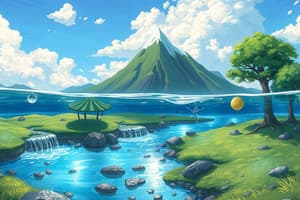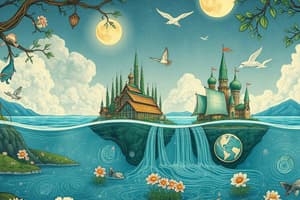Podcast
Questions and Answers
Match the water cycle process with its description:
Match the water cycle process with its description:
Evaporation = Water turns into vapor Condensation = Water droplets form clouds Precipitation = Water falls from the sky Infiltration = Water seeps into the ground
Water molecules are always completely neutral and do not have any charge differences between atoms.
Water molecules are always completely neutral and do not have any charge differences between atoms.
False (B)
What makes water a unique molecule that supports life on Earth?
What makes water a unique molecule that supports life on Earth?
Water's polarity, high heat capacity, and ability to act as a solvent are some of the properties that make it essential for life.
Which of the following best describes why water is essential for life?
Which of the following best describes why water is essential for life?
Water is composed of two hydrogen atoms and one _______ atom, with a chemical formula of H2O.
Water is composed of two hydrogen atoms and one _______ atom, with a chemical formula of H2O.
Which process involves water moving from plants into the atmosphere?
Which process involves water moving from plants into the atmosphere?
In a water molecule, the oxygen atom has a partial positive charge.
In a water molecule, the oxygen atom has a partial positive charge.
What is the chemical formula for water?
What is the chemical formula for water?
The process where water moves from the surface into the ground is called ______ .
The process where water moves from the surface into the ground is called ______ .
Match the following salts with the effect they have on the acidity or basicity of water:
Match the following salts with the effect they have on the acidity or basicity of water:
What is the approximate bond angle between the hydrogen atoms in water?
What is the approximate bond angle between the hydrogen atoms in water?
A solution is considered acidic if it has more hydroxide ions than hydrogen ions.
A solution is considered acidic if it has more hydroxide ions than hydrogen ions.
What type of bond holds the hydrogen and oxygen atoms together in a water molecule?
What type of bond holds the hydrogen and oxygen atoms together in a water molecule?
Water molecules attach to each other through ______ bonds.
Water molecules attach to each other through ______ bonds.
What is the approximate mass percentage of oxygen in a water molecule?
What is the approximate mass percentage of oxygen in a water molecule?
What percentage of the Earth's surface is covered by the hydrosphere?
What percentage of the Earth's surface is covered by the hydrosphere?
The majority of the Earth's water is freshwater found in rivers and lakes.
The majority of the Earth's water is freshwater found in rivers and lakes.
Name three forms of water as it exists on Earth.
Name three forms of water as it exists on Earth.
The process where water evaporates from plant leaves is known as __________.
The process where water evaporates from plant leaves is known as __________.
What property of water allows it to effectively transport nutrients and wastes within organisms?
What property of water allows it to effectively transport nutrients and wastes within organisms?
The process of condensation in the water cycle involves water vapor turning into ice.
The process of condensation in the water cycle involves water vapor turning into ice.
Besides the sun, what process in the water cycle helps move water from the earth to the atmosphere?
Besides the sun, what process in the water cycle helps move water from the earth to the atmosphere?
Water's high ______ ______ contributes to temperature regulation on Earth.
Water's high ______ ______ contributes to temperature regulation on Earth.
Which of these reasons best explains why water is essential for life?
Which of these reasons best explains why water is essential for life?
Flashcards
Water Cycle
Water Cycle
The continuous movement of water on, above and below the surface of the Earth.
Evaporation
Evaporation
The process where liquid water changes into water vapor and rises into the atmosphere.
Condensation
Condensation
The process where water vapor in the atmosphere cools and condenses into tiny water droplets, forming clouds.
Precipitation
Precipitation
Signup and view all the flashcards
Infiltration
Infiltration
Signup and view all the flashcards
Water Molecule Formation
Water Molecule Formation
Signup and view all the flashcards
Water's Unique Properties for Life
Water's Unique Properties for Life
Signup and view all the flashcards
Water as a Solvent
Water as a Solvent
Signup and view all the flashcards
Water's Importance for Life
Water's Importance for Life
Signup and view all the flashcards
Water's Role as a Solvent
Water's Role as a Solvent
Signup and view all the flashcards
Water's Temperature Regulation
Water's Temperature Regulation
Signup and view all the flashcards
Water's Role in Photosynthesis
Water's Role in Photosynthesis
Signup and view all the flashcards
The Water Cycle
The Water Cycle
Signup and view all the flashcards
Surface Runoff
Surface Runoff
Signup and view all the flashcards
Water Molecule Bond Angle
Water Molecule Bond Angle
Signup and view all the flashcards
Water's Polarity
Water's Polarity
Signup and view all the flashcards
Study Notes
Water Cycle Processes
- Evaporation: Water turns into vapor.
- Condensation: Water vapor forms clouds.
- Precipitation: Water falls from the sky.
- Infiltration: Water seeps into the ground.
Water's Chemical Reaction Steps
- Hydrogen atoms bond.
- Oxygen atom attracts electrons.
- Partial charges form.
- Water molecule is created.
Water Properties
- Water molecules are not always completely neutral; differences in charge occur between atoms.
- Water's unique properties support life on Earth.
- Water supports cellular functions and biochemical reactions.
- Water provides color to living things.
Studying That Suits You
Use AI to generate personalized quizzes and flashcards to suit your learning preferences.




